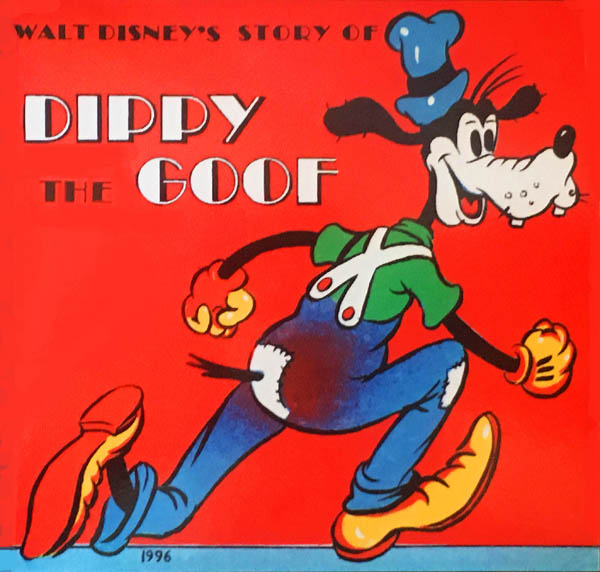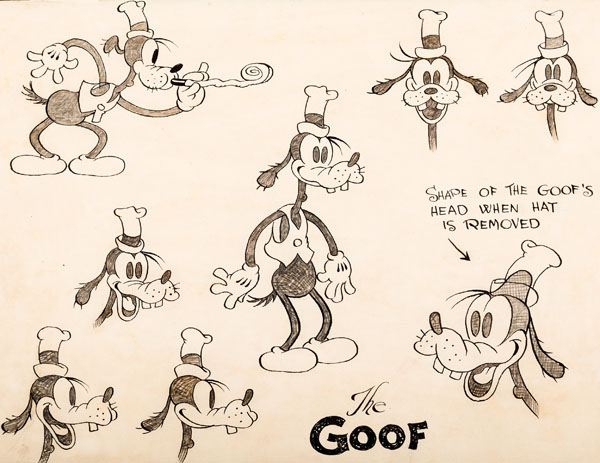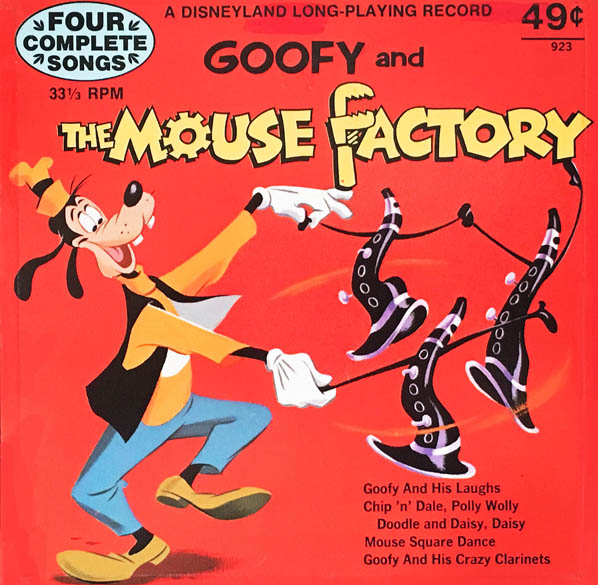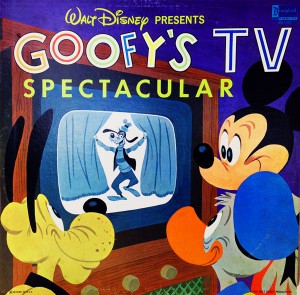Since he stumbled along 89 years ago, Goofy “gawrshed” his way from 78’s to music streams and hasn’t stopped spinning since.

WALT DISNEY’S STORY OF
DIPPY THE GOOF
Applewood Press ISBN 1-55709-355-5 (Compact Disc with Book / Mono)
Released in 1996. Adapted from Disney comic stories by Floyd Gottfredson. Based on the Whitman “1066 series” book, originally published in 1938. Limited Edition of 2,500 Copies. Recorded at Score One Studios, Hollywood. Running Time: 24 minutes.
Voices: Bill Farmer (Dippy Dawg, Horace Horsecollar/Narrator, Pluto); Russi Taylor (Clara Cluck); Wayne Allwine (Mickey Mouse).
“A goof by any other name would be just as dippy…”
One thing is for sure. His original name was Dippy Dawg, and he made his first appearance in the 1932 short, Mickey’s Revue. What his name was for the next few years gets a little iffy and whatty.
Though Goofy’s official moniker was generally established in his first solo starring cartoon, Goofy and Wilbur in 1939, for the first few years of his career, his name varied–even within the same stories. (He’s not alone, as “Davy Crockett” star Fess Parker recalled that some referred to him “Fezz” when he was new to the Disney lot. Your author also had an uncle who went by the names of Dan, Don, Carmine and Nick, and a genius at dunking donuts without getting a crumb in his coffee.)
Our esteemed colleague David Gerstein (co-author, with the esteemed J.B. Kaufman, of Walt Disney’s Mickey Mouse: The Ultimate History and editor of the ongoing Disney Masters Collection book series, shared the serpentine saga of Goofy’s incredible journey through the studio I.D. process:
“The name ‘Dippy Dawg,’ spelled as such, was used in publicity for that Mickey’s Revue and on-screen in “Ye Olden Days” [1932]. As early as summer 1932, however, when the first regular model sheet was drawn up for his second appearance in “The Whoopee Party”, the model sheet called him simply “The Goof,” evidently because some in the studio preferred it. So the stage was set for some confusion from the start.
In January 1933, when he appeared in the comic strip, he was called ‘Dippy Dog’ (note spelling) and remained such for three years, the only change being “Dog” to “Dawg” in the summer of 1933.
In March 1934, on an episode of the Heinz Hall of Fame radio program where Walt and his characters appeared as guests, the name ‘Goofy’ was used for the character, with no uses of ‘Dippy’ at all. This is the earliest use of ‘Goofy’ I’m aware of.
“In late 1934, Mickey Mouse Magazine began using the new name as well, sometimes spelling it “Goofie” in the beginning. All kinds of variant names—’Dippy Dawg,’ ‘Dippy the Goof,’ ‘The Goof,’ ‘Dippy Goof’ and ‘Goofy’–were used interchangeably in Mickey Mouse Magazine text stories, and other books and periodicals from Hal Horne and Western Publishing/Whitman, all the way up to World War II.
“In late 1935, with On Ice, the character design was famously changed by Art Babbitt to give him more clothes and a bigger chin. This was generally concurrent with an overall shift to the name ‘Goofy’ in most merchandise, and in the comics in Jan 1936.”
But there were exceptions, even after 1936, like Walt Disney‘s Story of Dippy the Goof, one of six small storybooks cataloged as the “1066” series from Western Publishing in 1938. Western Publishing, printer of Whitman Books, was one of Disney’s largest licensees. David Gerstein explains:
“Because Whitman produced so much content, they kept confusion going for a while. They were still capable of publishing that book in 1938 that we’re discussing, “Walt Disney’s Story of Dippy the Goof”, and using interchangeable variant names inside, even though the book was a retelling of Gottfredson comics produced entirely after the shift. In effect, Gottfredson wasn’t uncertain at all about Goofy’s name, but the Western prose writer ‘introduced’ the uncertainty. There are even occasional references to Goofy as Dippy as late as Western’s first Walt Disney’s Comics and Stories issues in 1941.
“In Argentina, Goofy remained ‘Dippy’ into approximately the 1970s, as in this example. And to be fair, in the comics in recent years, we’ve tried to have it both ways by giving Goofy’s full name as ‘Goofus D. Dawg’, a name that was introduced by Pat McGreal in the late 1990s. Technically, this way he’s both ‘Goofy’ and ‘Dippy Dawg’–though other media still have characters call him ‘Mr. Goof,’ so there’s still no consistency.”

Which brings us to our Feature Presentation. In 1996, the CD recording of Walt Disney‘s Story of Dippy the Goof was faithfully performed from the original 1938 Whitman hardcover storybook, word-for-word, as well as the other five “1066” series books for sound recordings. All six reproductions were reproduced as they looked in 1938, each packaged with their own individual discs and published by Applewood Books.
There are no other official English language audio recordings in which Disney characters refer to Goofy as “Dippy,” as far as David has discovered, since they are faithful to the original 1938 texts. Our hero also appears in two other books in the series: Walt Disney‘s Story of Mickey Mouse and Walt Disney‘s Story of Minnie Mouse. In all the books and recordings, the narrative refers to him by his various names at random. Mickey Mouse usually calls him “Goofy,” but not always. David offers further details regarding the Applewood books and CDs in an earlier Animation Spin saluting buena bovine Clarabelle Cow.
No matter what the name, he’s brilliantly played by Bill Farmer, a self-effacing actor capable of remarkable depth in the role of Goofy, as he has proven repeatedly in such classics as A Goofy Movie (which is explored in this Animation Spin and Prince and the Pauper. Bill has been voicing Goofy for over a third of the character’s history. On the Dippy disc, he once again proves his skill in varying the voice range of not out our dizzy pal, but also the voluminous narration, in character, of Horace. These disc sets are among the most dialogue-heavy productions produced with the Disney “fab five.”
“I remember the sessions fairly well,” Bill Farmer recalled. “We modified Horace’s voice from the original one I did in Prince and the Pauper. We settled on a much more southern-sounding voice, and that seemed to fit the narrative style that Disney was looking for.”
“Dippy’s Garden Mystery”
In this excerpt from Walt Disney‘s Story of Dippy the Goof, Mickey helps Dippy dig up his entire garden to find what “The Goof” has misplaced.

GOOFY AND THE MOUSE FACTORY
Disneyland Records – Four Complete Songs Series FS-923 (7” 33 1/3 RPM LP / Mono)
Released in 1972. Executive Producer: Jimmy Johnson. Producer: Tutti Camarata. Running Time: 7 minutes.
Voices: Pinto Colvig (Goofy); the voices of Chip and Dale are uncredited but could have been voiced by Gloria Wood, Robie Lester and/or Teri York.
Songs and Melodies: “Mouse Square Dance” by Camarata; “Chip ‘n Dale” by Gil (Hazel) George, Oliver Wallace; “Daisy, Daisy (Crazy Over Daisy)” by Oliver Wallace; “Turkey in the Straw,” “Dixie” “The Wearing of the Green,” “Polly Wolly Doodle” (Traditional).
Monologues: “Goofy and His Laughs,” “Goofy and His Crazy Clarinets”.
 The highly unusual reissue compilation album Goofy’s T.V. Spectacular (1965), which we discussed some time ago in another Animation Spin, featured Pinto Colvig hosting a grab-bag of previously released Disneyland Records tracks, some material new to vinyl and assorted comic touches. Goofy and The Mouse Factory is a seven-inch little LP presenting three tracks from the album, which by 1972 had long been discontinued.
The highly unusual reissue compilation album Goofy’s T.V. Spectacular (1965), which we discussed some time ago in another Animation Spin, featured Pinto Colvig hosting a grab-bag of previously released Disneyland Records tracks, some material new to vinyl and assorted comic touches. Goofy and The Mouse Factory is a seven-inch little LP presenting three tracks from the album, which by 1972 had long been discontinued.
The little disc was one of several records created to tie in with the studio’s syndicated Mouse Factory TV series, itself also a mix of existing film materials hosted by famous names and costumed Disney characters. No soundtrack elements from The Mouse Factory were provided for records, so everything on the corresponding discs was culled from earlier records. Mickey and Donald were given the little LP Mouse Factory four-song record treatment as well.
Goofy’s disc is characteristically kooky. The record series promised “four complete songs.” A bit of head-scratching must have gone on when selecting the cuts. Disneyland had not recorded a lot of songs with Goofy, but there were enough (such as “Laugh, Laugh, Laugh,” and “Knock, Knock, Who’s There?” from the Children’s Riddles and Games Songs LP) to make a count of four without having to bring in Chip ‘n Dale to account for three of them.
The decision to give one track to Chip ‘n Dale made the record a little more musical, because their single track is a three-song medley. In a way, this record offers seven selections in total: four songs, two short monologues and a “Crazy Clarinets” instrumental medley at the end. Even the math was goofy!
“Laugh, Laugh, Laugh”
This is very similar to the opening of both Goofy and the Mouse Factory (which comes from Goofy’s T.V. Spectacular), so it gives the general idea of Goofy talking about laughter. It originates from another LP, Children’s Riddles and Game Songs, which was explored in this Animation Spin. You will hear Goofy laughing along with a room full of kids who were either working on projects at the Disney studio at the time or related to staff members.
“Mr. Chip ‘n Mr. Dale & The Goofy Song”
Since Goofy’s birthday is this month, how about one spinning one more record? This is the flip side of a Chip ‘n Dale tune sung by a speeded-up Anne Lloyd with the Sandpipers, and then Pinto Colvig himself as Goofy. It also appeared on the Golden album Walt Disney’s Song Parade, which you can read about in this Animation Spin.


 GREG EHRBAR is a freelance writer/producer for television, advertising, books, theme parks and stage. Greg has worked on content for such studios as Disney, Warner and Universal, with some of Hollywood’s biggest stars. His numerous books include Mouse Tracks: The Story of Walt Disney Records (with Tim Hollis). Visit
GREG EHRBAR is a freelance writer/producer for television, advertising, books, theme parks and stage. Greg has worked on content for such studios as Disney, Warner and Universal, with some of Hollywood’s biggest stars. His numerous books include Mouse Tracks: The Story of Walt Disney Records (with Tim Hollis). Visit 






















































“Think of the Goof as a composite of an everlasting optimist, a gullible Good Samaritan, a half-wit, a shiftless, good-natured hick.” — Art Babbitt
Funny, just earlier today I was reading your older post about the Clarabelle the Cow record, which also discussed “Dippy the Goof”.
That’s a great cover illustration of Goofy dancing with the clarinets, and I wish you could have included the “Crazy Clarinets” monologue with this post. A big part of Pinto Colvig’s vaudeville routine was playing the clarinet out of tune and making funny noises with it. He was actually quite a good clarinetist but, like Jack Benny with his violin, found that he got more laughs when he played it badly.
I recall hearing (probably as a DVD extra) an Armed Forces Radio broadcast from World War Two that included the principal Disney characters of the time, with Goofy introduced as “Goofy Horsecollar”. He (or rather Pinto) spoke of his life as an army horse, and I seem to remember that he played a bit of clarinet as well. To my knowledge this was the only official appearance of Goofy in any medium in which he was defined as any animal other than a dog, though there has been some dispute on this point over the years in some quarters.
I read that Bill Farmer started out as a teenager doing various character voices in fast food drive-thrus for the amusement of his friends. His first audition in Hollywood was for Goofy, and he nailed it and has held onto the gig ever since. Way to go, Bill!
Believe it of not, that Chip ‘N Dale song (with different lyrics, of course) was used in a radio commercial for Pitney Bowes office equipment that aired on classical radio stations in the 1980s. “Absolutely, Mister Pitney! Positively, Mister Bowes!”
The variety of monikers Goofy has assumed over the years is perhaps a reflection of his versatility as a character. Over the years he has appeared in a wide range of guises, situations and settings, yet always remains recognisably Goofy precisely because he is a comic Everyman with whom we can all identify. We love him, not in spite of his flaws, but because of them; and, contrary to the two-panel morality plays in Highlights magazine, he proves that a Goofus, however dippy, can also be Gallant.
Happy birthday, Goofy!
May we all live at least as long as you,
But maybe grow a little wiser, too!
There are many ambiguities associated with Goofy. Not only the variety of names. Speaking of which, there is also Mr. Geef from the late 40’s and early 50’s cartoon shorts. But also regarding his species. If Goofy is a dog, what is Pluto? Why does Goofy stand upright on two feet while Pluto generally goes around on all fours? And is Goofy single or is he married? Does he have a son named Goofy Junior or is his son named Max? And what about his nephew Gilbert? Does Goofy really have a nephew who is a genius? Does his nephew live with him or does Goofy live all by himself? And does Goofy have an alter ego, super-hero persona named Super Goof?
Those Applewood recreations of 30’s books look like an amazing project. It’s rare to find connections between Disney printed stories and stories presented in other media, which are usually cinema-based. In terms of sheer output, I would venture to guess that to date Bill Farmer has voiced Goofy more than even the great Pinto Colvig. He truly seems to “own’ the character in his vocal interpretations.
At first glance, those small Mouse Factory records would appear to be derived from the larger Mouse Factory album issued several months earlier. So when I first saw the little records I almost didn’t get them, since I already had the big album. But fortunately, the store where I found them was having a sale on records that day, so I was able to get them all very reasonably. Then once I played them I discovered that they contained quite a bit of different material–actually, a very unusual move for Disneyland Records, where more often than not the smaller records were derived directly from the related larger albums.
The Chip ‘n’ Dale song is actually a reworking of the old “Mr. Gallagher and Mr. Shean” vaudeville song (which can be seen and heard as winningly performed by Charles Winninger and Al Shean in the MGM film “Ziegfeld Girl”). Listeners of the time would still have remembered that song–at least, the parents and grandparents of the original listeners would have caught the reference. Amazing how far the legacy of vaudeville has stretched forward into time.
Great post, as always!
I always think of George Geef as a character played by Goofy, like Marley in Mickey’s Christmas Carol
Disney has played with Goofy’s dog status in recent years. There was a short where Goofy sidelined Pluto before a big dog show and was pressured to take his place. Mickey said, “Beg!” and Goofy went, “Please, baby! I can change! Take me back!”
Animals seem to exist in both forms in Disney world. Mickey has a pet dog, Goofy has gone duck hunting, and Donald’s nephews have raised white mice; a round robin.
A couple things you didn’t mention. The 1955 Disneyland special “The Goofy Success Story” has him sign an acting contract with “Dippy Dawg” as his given name; the name “Goofy” is introduced as an executive-chosen stage name. In addition, the pilot episode of “Goof Troop” has him receiving a diploma with the name “G. G. Goof”.
There are probably many more I did not mention, including my own name for him, which probably existed somewhere before. When Disney participated in a National Association of Broadcasters event, Peter Emslie, Jim Story and I came up with an invitation depicting the characters in a radio station–Mickey doing the news, Roger Rabbit as DJ and, in silhouette behind a frosted glass office door, “J.J. Geef” of Sales. He was frantically doing a song and dance routine.
It’s splitting (dog-)hairs here, but “The Goofy Success Story” somehow uses the 1933 comics spelling: DOG, not DAWG.